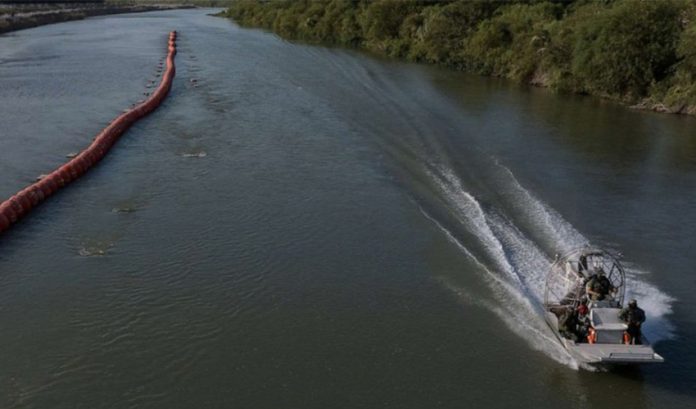Two bodies have been found floating in the Río Grande on the United States border, including one that was caught in a barrier of buoys installed last month on the orders of Texas Governor Greg Abbott.
In a statement on Wednesday, the Foreign Ministry (SRE) said that Mexican authorities are working to recover and identify the bodies, presumed to be migrants who were trying to cross to the United States.
The SRE also condemned the 305-meter-long buoy barrier, which was installed in July near Eagle Pass and is intended to make it more difficult for migrants to swim across.
“We reiterate the position of the Government of Mexico that the placement of chained buoys by Texas authorities is a violation of our sovereignty,” the SRE said. “We express our concern about the impact on the human rights and personal safety of migrants of these state policies, which run counter to the close collaboration between our country and the United States federal government.”
DOJ says they will sue Texas over buoy wall barrier in Rio Grande https://t.co/GeSndBgQwi
— Alison Cook (@alisoncook) July 21, 2023
The buoy wall installed in the Rio Grande by the government of Texas.
The discovery of the bodies comes just days after the U.S. Department of Justice filed a lawsuit demanding that Texas remove the floating barrier, due to humanitarian and environmental concerns.
However, U.S. authorities stressed that the cause of the recent deaths is unclear. Only one of the bodies was found caught in the buoys, while the other was discovered about five miles upstream. Migrants drown frequently in the Rio Grande, and it is unknown whether these two deaths were connected.
“Preliminary information suggests that this individual [found caught in the buoys] drowned upstream of the sea barrier and floated toward the buoys,” said Steve McCraw, director of the Department of Public Safety. “There are personnel stationed at the sea barrier at all times in case any migrants try to cross.”
The floating barrier is the latest attempt by Texas to reinforce the border, which has also included erecting wire fences and prosecuting migrants for trespass. President Andrés Manuel López Obrador has previously denounced the barrier as a “propaganda act of the Governor of Texas” and demanded it be removed.

At his Thursday morning press conference, AMLO reiterated his criticism of Governor Greg Abbott. “He shouldn’t act like that, it’s inhumane,” AMLO said. “Nobody should be treated like that, that’s not what good people do.”
AMLO insisted that irregular migration had already dropped by as much as 50% between May and June, before the installation of the buoys. He attributed this to the end of Title 42, the pandemic-era immigration policy that allowed the U.S. to immediately expel asylum seekers to Mexico on public health grounds.
Since Title 42 ended on May 12, Mexican and U.S. authorities have reached new agreements to offer more legal pathways for asylum seekers trying to reach the U.S. and to expand development programs in Central America and the Caribbean.
“We can’t resolve the migration problem, which has social roots, with coercive measures,” AMLO said. “Nothing is fixed by militarizing the border, installing buoys or walls.”
With reports from The San Diego Union-Tribue, ABC News, Aristegui Noticias and El Heraldo de México
